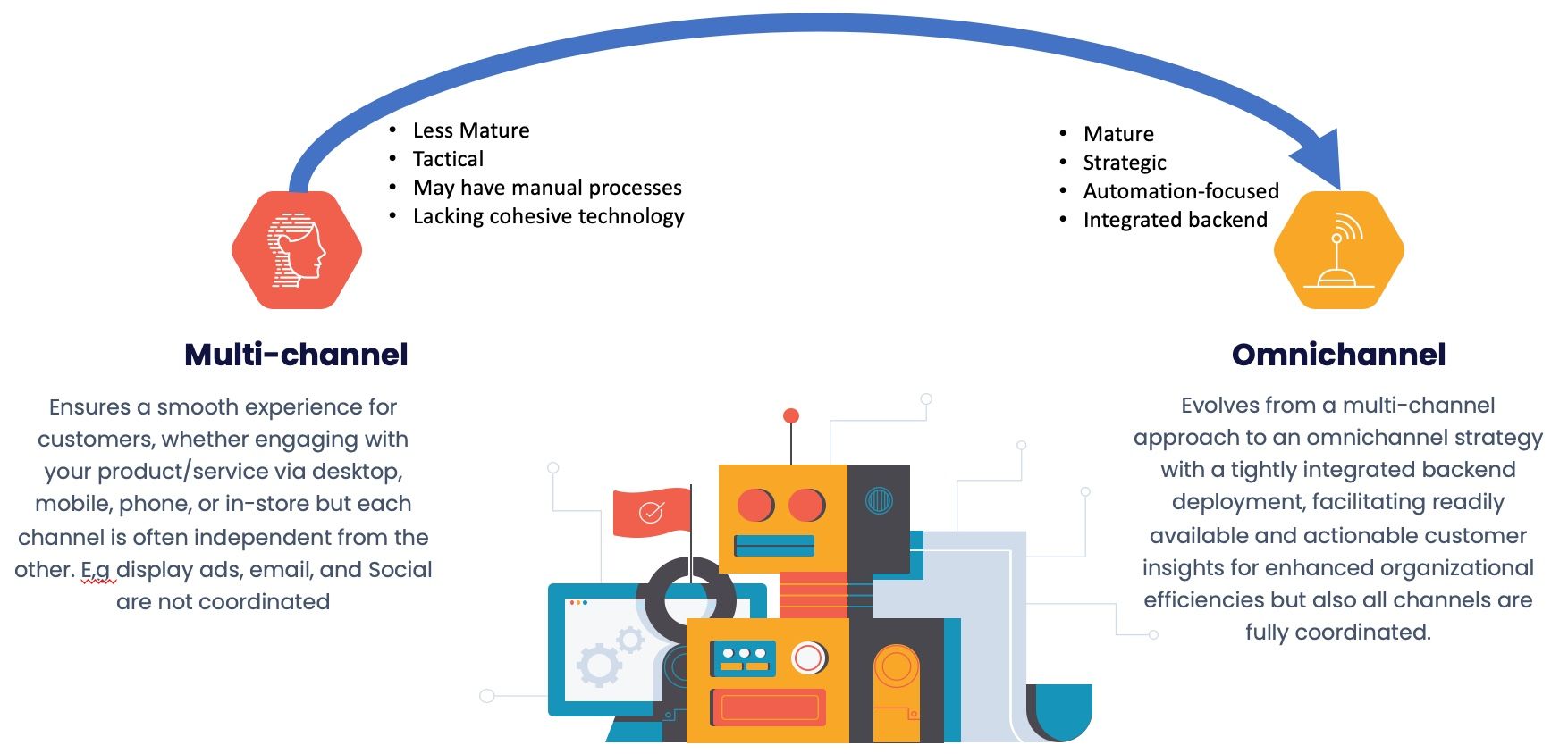Part 1: Personalization: Unveiling the Power of Omnichannel vs. Multi-channel Strategies
Introduction
In the ever-evolving realm of digital marketing, personalization has emerged as a dynamic force that reshapes how businesses engage with their audiences. No longer confined to traditional mass marketing methods, personalized experiences have swiftly become the cornerstone of successful customer interactions. In an era where consumers are inundated with information and choices, the ability to deliver personalized, targeted, relevant content has proven to be a pivotal differentiator. The convergence of advanced technologies, data analytics, and a profound shift in customer expectations has driven this transformation.
Tailored Experiences and Their Impact
Imagine receiving a marketing message catering to your preferences, needs, and behaviors. This level of tailored communication captures attention and cultivates a deep sense of connection. Up to now, the reality has only been Multi-channel marketing, but Omnichannel is the goal. The article will define and discuss these two approaches below. The truth is that they both fall under the umbrella of Personalization(P13N) and is the art of crafting such experiences — the category encompasses many technologies and sub-systems as well as roles and approaches across verticals - it's about tailoring content, recommendations, and interactions to resonate uniquely with each individual, no matter the channel, industry vertical, type of customer profile, or category of products - the goal is the same. The outcome is profound: elevated customer engagement, fortified brand loyalty, and increased conversion rates. But make no mistake, realizing Omnichannel is immensely difficult in a fully coordinated automated way.
In a digital landscape where competition is fierce, and consumer attention is fleeting, businesses are compelled to harness the power of personalization to remain relevant and impactful. More is needed to rely on generic outreach; customers expect brands to understand their preferences and deliver content that aligns with their interests. This shift has prompted a fundamental rethinking of marketing strategies, prompting a shift from mass communication to individualized conversations. As technologists, we knew this was fast approaching. FPD(First-Party Data) vs. TPD(Third-Party Data), cookie apocalypse, Tagging vs. APIs and SDKs, and the emergence of Gen-ai, greatly impact personalization and how we engage with each other.
Unveiling the Objectives
This article aims to delve deep into personalization within digital marketing, focusing mainly on the divergent approaches of omnichannel and multi-channel strategies. As the digital landscape expands with various platforms and channels, understanding how to personalize experiences across these mediums effectively is crucial - some industry verticals are better at doing this than others. The laggards could learn from the early adopters. In the subsequent sections and part 2 and possibly part 3 articles, the content will dissect some of the nuances, benefits, and challenges of both omnichannel and multi-channel marketing, highlighting the distinct ways in which they employ personalization to engage and resonate with audiences. We may even brush up against some of the Machine learning strategies and approaches that have been used and tested already by the early adopters and what might be fast approaching this area to speed up the curve for laggards.
By embarking on this journey, the article aims to equip marketers, businesses, and enthusiasts alike with a comprehensive understanding of how personalization operates within these two strategies. With this knowledge, you can decide which approach best aligns with your organization's objectives, resources, and audience preferences.
The Evolution of Personalization in Digital Marketing
From Basic Segmentation to AI-Driven Personalization
The journey of personalization in digital marketing has traversed a fascinating evolution, evolving from rudimentary audience segmentation to intricate AI-driven customization. In its early stages, personalization was primarily achieved through basic demographic categorization, which allowed marketers to create somewhat targeted content based on broad attributes like age, gender, and location. While this approach represented a significant leap from mass marketing, it barely scratched the surface of what personalization could achieve.
As technology progressed, especially the web analytics tools to collect almost anything imaginable, so did the tools and techniques available to marketers. The introduction of website cookies and user tracking allowed for user behavior tracking, leading to behavioral targeting. This era saw the birth of recommendations based on browsing history and purchase patterns. Amazon, for instance, championed this form of early personalization, suggesting products based on a user's previous interactions. Other vendors sprouted from those efforts, like RichRelevance, Dynamic Yield, and others - that companies like Adobe sucked up as part of their strategy to dominate the martech space.
However, integrating artificial intelligence (AI) and machine learning catalyzed personalization's evolution. With the capacity to process vast amounts of data and discern intricate patterns, AI-driven personalization became a game-changer. Marketers could now craft hyper-personalized experiences that accounted for a user's behavior, preferences, and even real-time context. It's worth noting that early adopters of AI-driven personalization, such as Adobe and RichRelevance, were at the forefront of advocating its potential. RichRelevance has been subsequently merged into a larger company called Algonomy which specializes in Speciality retail and has many more products in the martech stack. They are particularly heavy on using machine learning and deep learning in their personalization solutions.
Consumer Expectations and Demand for Relevance
In parallel with these advancements, consumer expectations have undergone a seismic shift. Today's digital consumers are savvy and discerning; they demand more than just superficial interactions. They expect brands to understand their preferences and tailor their experiences accordingly. The era of one-size-fits-all marketing messages has waned, replaced by the era of relevance.
Adobe, a trailblazer in martech, recognized this shift early on. They championed the idea that personalization is not merely about addressing a consumer by their first name but about delivering content that genuinely resonates with their aspirations. Many of Adobe's suite of tools, including Adobe Target, Experience Manager, Campaign, and many other solutions they sell, empower marketers to orchestrate personalized experiences across various touchpoints. This transition from simple personalization to deep relevance showcases the evolution of personalization's role from being a value-add to becoming a business imperative. Adobe promotes this as CX or Customer Experience. While they started with the delivery tools they have now, like others following suit, moved into the tools and processes needed upstream to reconcile the customer profile and related events that trigger the personalization in a very coordinated way across all channels. AKA Omnichannel personalization.
Impact on Business Success
The impact of personalization on business success is undeniable. Studies and statistics underscore the tangible benefits of delivering tailored experiences to customers. According to a survey by Epsilon, over 80% of consumers are more likely to make a purchase when brands offer personalized experiences. In fact, businesses that deploy advanced personalization strategies often witness a substantial increase in customer engagement and conversion rates.
RichRelevance (Now Algonomy at https://www.algonomy.com), a leader in experience personalization, exemplified the transformative impact of personalization. Their solutions led to a 25% increase in average order value for some clients and a noteworthy surge in customer retention. Such outcomes underscore how personalization is not just a fancy buzzword but a strategic approach directly translating into quantifiable results.
As we navigate the intricate landscape of digital marketing personalization, it's clear that a fusion of technological innovation and evolving consumer preferences have driven the journey from basic segmentation to AI-driven personalization. The pioneers in this realm, like Adobe and RichRelevance, have not only championed these advancements but also demonstrated their real-world effectiveness. In the subsequent sections, we will unravel the nuances of personalization through the contrasting lenses of omnichannel and multi-channel marketing, shedding light on how they harness these strategies to engage audiences uniquely and effectively.
Understanding Omnichannel and Multi-Channel Marketing
Defining Omni-Channel and Multi-Channel Marketing Approaches
In modern marketing, two distinct strategies have emerged to engage customers across diverse touchpoints: Omnichannel marketing and Multi-channel marketing. While these terms are often used interchangeably, they represent distinct approaches with unique personalization implications. Let's define them.

Multi-Channel Marketing: Multi-channel marketing, on the other hand, involves establishing a presence across various channels without the same level of interconnectedness as Omnichannel. Each channel operates independently in a multi-channel strategy with its objectives, content, and interactions. While this approach allows brands to reach customers on diverse platforms, it may result in less cohesive experiences and inconsistent messaging.
Omni-Channel Marketing: Omnichannel marketing represents a holistic and integrated approach to customer engagement. It revolves around creating a seamless and consistent customer experience across all touchpoints, whether online or offline. In the Omni-channel ecosystem, channels are interconnected, enabling customers to transition effortlessly between them while maintaining a coherent experience. The emphasis is on delivering a unified message and personalized content, ensuring each interaction is contextually relevant.

Core Concepts, Goals, and Key Characteristics
In Multi-channel marketing, the core concept is establishing a presence across various channels to expand reach. The goal is to increase brand exposure and engage customers through their preferred platforms. While multi-channel marketing allows for broader reach, it's essential to note that a lack of integration can lead to challenges in delivering personalized experiences consistently.
On the other hand, in Omnichannel marketing, the core concept is to provide customers with a seamless journey, irrespective of the channels they engage with. The goal is to create a unified brand experience that fosters loyalty and trust. Omnichannel marketing is characterized by data integration, allowing businesses to gather insights from multiple channels and tailor interactions based on a comprehensive view of each customer's behavior and preferences.
Importance of Seamless Customer Experiences
Omnichannel and Multi-channel marketing emphasize the importance of seamless customer experiences, albeit through different means. In Multi-channel marketing, delivering seamless experiences becomes more challenging due to the relatively independent nature of each channel. However, this doesn't diminish the significance of coherence. Even though customers might interact with a brand through multiple channels, they still expect a consistent brand identity, messaging, and overall experience. Ensuring that personalization remains consistent across these diverse platforms is a challenge that businesses must address to create lasting impressions.
In Omnichannel marketing, the interconnectedness of channels aims to eliminate friction points. Customers can start an interaction on one channel and continue it seamlessly on another, maintaining context and continuity. This fluidity enhances personalization efforts, allowing marketers to offer relevant content based on customer journeys across channels. There are very few martech vendors that can help with the full potential of Omnichannel marketing and note, many brands have not mastered it. The technology, the consumer identity, the CX journey, and the marketing processes to keep up with content velocity are extreme. Make sure you account for all these factors because there are costs, effort, and extreme complexity to make it all come together and happen.
As we delve further into personalization, we must recognize the foundation upon which these strategies are built. Omnichannel and Multi-channel marketing represent divergent paths, each with its set of strengths and challenges. In the subsequent articles, we will explore how personalization is enacted within these frameworks, examining how tailored experiences are brought to life and how they shape customer relationships.
Here are some topics and sections in some subsequent articles I plan to address.
- The Role of Personalization in Omnichannel Marketing
- The Complexity of Omni-Channel Personalization
- Key Differences: Omnichannel vs. Multi-Channel Personalization
- Implementing Personalization Strategies
- Case Studies: Personalization Triumphs
- Navigating Challenges and Best Practices
- Looking Ahead: The Future of Personalization
Thank you for reading, and I hope you gained some value from this first part.






Member discussion